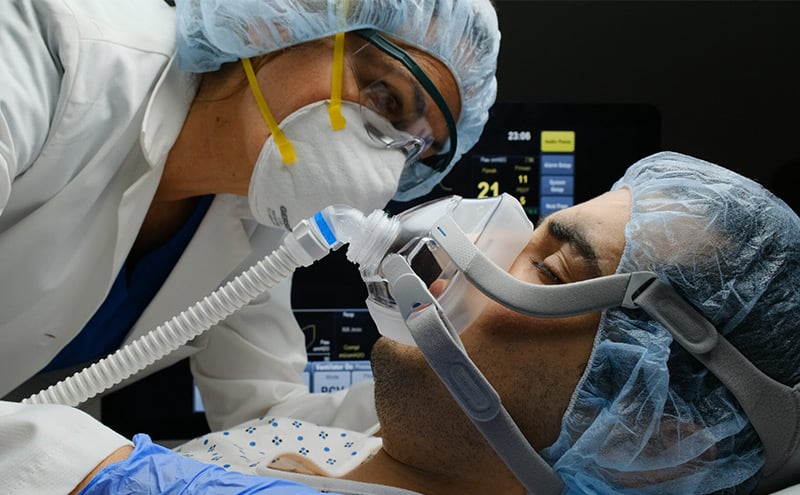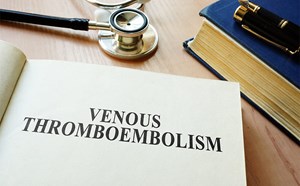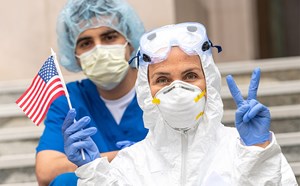
Tummy Time: Prone Positioning for Non-Intubated Patients in the ED


As of June 2020, there have been over seven million cases of COVID-19 worldwide, with approximately 40% of hospitalized patients developing acute hypoxemic respiratory failure and acute respiratory distress syndrome (ARDS).1 Novel applications of existing therapies, such as prone positioning (PP), have been proposed to support patients with acute hypoxemic respiratory failure due to COVID-19. While PP has been demonstrated to improve mortality in mechanically ventilated patients with moderate-to-severe ARDS, its use in non-intubated patients has historically been limited. This article will review the background, physiology, literature, and logistics of PP for non-intubated patients with acute hypoxemic respiratory failure in the ED or ICU settings.
Among intubated patients, proning has shown to be most beneficial in patients with moderate and severe ARDS. Numerous trials dating back to the 1990s demonstrated that prone positioning leads to improvement in oxygenation, but none demonstrated a mortality benefit.2-4 The landmark Prone Positioning in Severe ARDS (PROSEVA) trial found, in patients with moderate to severe ARDS, that prone positioning led to a 17% absolute reduction in both 28 and 90-day mortality.5 A subsequent meta-analysis confirmed that PP was most effective in lowering mortality among patients with moderate to severe ARDS and when used for periods of 12 hours or greater.6 Current guidelines recommend the use of PP in sessions of sixteen hours or greater in patients with moderate to severe ARDS.7
Prone positioning improves hypoxemia and reduces alveolar stress via several mechanisms. The dorsal areas of the lungs contain more parenchymal tissue and receive greater perfusion than other lung regions. When supine, they are also subject to compression by the heart, anterior lung tissue and abdomen, which is magnified when lungs are edematous in ARDS. Prone positioning not only allows for more uniform distribution of compressive forces but also increased recruitment in dorsal regions, leading to more uniform distribution of tidal volumes to lung parenchyma, leading to less alveolar injury.8 Additionally, decreased hyperinflation of non-dependent lung regions is hypothesized to reduce mechanical lung injury.9 Redistribution of blood flow due to gravitational forces also likely plays a minor role, with the net result being improved ventilation/perfusion (V/Q) matching.
Using PP in awake, non-intubated ICU patients with ARDS had been trialed prior to the COVID pandemic. In a small study of twenty ICU patients with moderate and severe ARDS, eleven out of twenty patients (55%) avoided intubation with the use of PP and non-invasive ventilation or high flow nasal cannula.10 Oxygenation also improved, most dramatically in the patients treated concomitantly with high-flow nasal cannula.
Expanding PP to the emergency department (ED) has potential benefits in non-intubated COVID patients as an early intervention for hypoxemia and ARDS, while potentially avoiding or reducing intubation needs in the setting of limited ventilator capacity. In a recent case series from New York, a total of 50 adult ED patients with COVID and persistent hypoxemia (median SPO2 of 84%, interquartile range [IQR] 69-85%) receiving supplemental oxygen via nasal cannula or face mask were allowed to self-prone.11 Within five minutes of self-proning, the median SPO2 increased to 94% (IQR 90-95%). A total of 18 patients (36%) eventually required intubation, 13 of whom were intubated within 24 hours.
Another study of COVID patients from Italy, by Sartini et al, also suggests PP may be useful in hypoxemic patients outside the ICU. In a small case series of fifteen general hospital ward patients receiving NIV, all patients experienced significant improvements in SPO2 and PaO2:FIO2 ratio during PP, and 80% had sustained improvement one hour after PP was completed.12 At a two week follow-up, a single additional patient had required intubation, one patient had died, and the remainder had improved and no longer required PP.
Failure to improve after a short trial of PP may be associated with higher risk for endotracheal intubation. In another single-center study of non-ICU COVID patients with hypoxemic respiratory failure receiving supplemental oxygen, all patients who were unable to tolerate PP failed within the first hour and required mechanical ventilation, with one additional patient requiring intubation at 10 day follow-up.13
PP also appears to be well-tolerated. In the above study, 83% of patients were able to tolerate PP periods of at least one hour and 63% were able to tolerate PP for three hours or greater.13 In the aforementioned Italian study, 73.3% of patients reported improvement in comfort during PP, and 86.7% reported improvement in comfort after PP. 12 In prior studies of non-intubated ICU patients, PP was also found to be well tolerated without major complications.10
Prior evidence has demonstrated a benefit in the use of PP with intubated patients in the ICU setting for patients with moderate to severe ARDS and time periods of several hours. PP is now emerging as a potential intervention in the setting of the COVID-19 pandemic. A lack of response to short periods of PP may serve as a useful indicator of individuals that will ultimately require mechanical ventilation. At the same time, early initiation of PP may reduce intubations and decrease ventilator use. As the use of PP becomes more widespread, it remains to be seen if this intervention will lead to sustained improvements in respiratory parameters and oxygenation beyond short periods of time, and whether these short-term physiologic benefits translate to improvement in mortality, ventilator-free days, or other patient-centered outcomes.
References
- Wu C, Chen X, Cai Y, et al. Risk factors associated with acute respiratory distress syndrome and death in patients with coronavirus disease 2019 pneumonia in Wuhan, China. JAMA Intern Med. 2020 Mar 13;180(7):1-11. doi: 10.1001/jamainternmed.2020.0994.
- Chatte G, Sab JM, Dubois JM, et al. Prone position in mechanically ventilated patients with severe acute respiratory failure. Am J Respir Crit Care Med. 1997 Feb;155(2):473-478.
- Guerin C, Badet M, Rosselli S, et al. Effects of prone position on alveolar recruitment and oxygenation in acute lung injury. Intensive Care Med. 1999 Nov;25(11):1222-1230.
- Alsaghir AH, Martin CM. Effect of prone positioning in patients with acute respiratory distress syndrome: a meta-analysis. Crit Care Med. 2008 Feb;36(2):603-609.
- Guérin C, Reignier J, Richard J-C, et al. Prone positioning in severe acute respiratory distress syndrome. N Engl J Med. 2013 Jun;368(23):2159-2168.
- Munshi L, Del Sorbo L, Adhikari NKJ, et al. Prone position for acute respiratory distress syndrome. A systematic review and meta-analysis. Ann Am Thorac Soc. 2017 Oct;14(Supplement_4):S280-S288.
- Papazian L, Aubron C, Brochard L, et al. Formal guidelines: management of acute respiratory distress syndrome. Ann Intensive Care. 2019 Jun 13;9(1):69.
- Johnson NJ, Luks AM, Glenny RW. Gas exchange in the prone posture. Respir Care. 2017 Aug;62(8):1097-1110.
- Scholten EL, Beitler JR, Prisk GK, et al. Treatment of ARDS with prone positioning. Chest. 2017 Jan;151(1):215-224.
- Ding L, Wang L, Ma W, et al. Efficacy and safety of early prone positioning combined with HFNC or NIV in moderate to severe ARDS: a multi-center prospective cohort study. Crit Care. 2020 Jan 30;24(1):28.
- Caputo ND, Strayer RJ, Levitan R. Early self-proning in awake, non-intubated patients in the emergency department: a single ED’s experience during the COVID-19 pandemic. Acad Emerg Med. 2020 May;27(5):375-378.
- Sartini C, Tresoldi M, Scarpellini P, et al. Respiratory parameters in patients with COVID-19 after using noninvasive ventilation in the prone position outside the intensive care unit. JAMA. 2020 May 15;323(22):2338-2340.
- Elharrar X, Trigui Y, Dols A-M, et al. Use of prone positioning in non-intubated patients with COVID-19 and hypoxemic acute respiratory failure. JAMA. 2020 May 15;323(22):2336-2338.
Toni Riveros, MD, MPH
University of Washington/Harborview Medical Center
Nick Johnson, MD, FACEP
University of Washington/Harborview Medical Center



